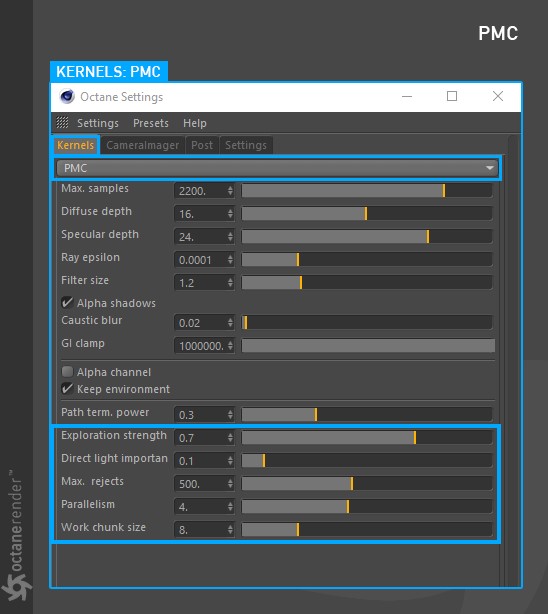
The PMC Kernel is a custom mutating unbiased kernel designed specifically for GPUThe GPU is responsible for displaying graphical elements on a computer display. The GPU plays a key role in the Octane rendering process as the CUDA cores are utilized during the rendering process. rendering. Rendering with PMC creates physically accurate lighting and caustic effects and is generally produces the highest quality result but can also take the most time to render depending on the scene. Figure 1 shows the Path tracing settings in the KernelsBy definition, this is the central or most important part of something. In Octane, the Kernels are the heart of the render engine. tab.

Figure 1: The PMC settings in the Kernels tab.
Maximum Samples
sets the maximum number of samples per pixel before the rendering process stops. The higher the number of samples per pixel, the cleaner the render. There is no rule as to how many samples per pixel are required for a good render, it is subjective and may vary depending on the content and complexity of the scene being rendered.
sets the maximum number of diffuse reflections when GI Mode is set to Diffuse.
Controls the number of time a ray can be refracted before dying. Higher numbers mean higher render times but more color bleeding and more details in transparent materials. Low numbers can introduce artifacts or turn some refractions into pure black.
Ray Epsilon
Is the distance between the geometry and the light ray when calculating ray intersections for lighting and shadowing. Larger values push rays away from the geometry surface. Lower values are more accurate, but can cause artifacts on large or distant objects. Ray Epsilon is similar to raytracing bias in other rendering engines. Adjust Ray Epsilon to reduce artifacts in large scale scenes.
Filter Size
Sets the filter size in terms of pixels. This can improve aliasing artifacts in the render. However, if the filter is set too high, the image can become blurry.
Alpha Shadow
Allows any object with transparency (specular materials, materials with opacity settings and alpha channels) to cast a shadow accordingly instead of behaving as a solid object.
Caustic Blur
Sets the caustic reflections to look sharp or soft. A low value will make the caustics look sharp. When high values are entered, the caustics begin to appear blurry.
GI Clamp
Clamps the contribution for each path to the specified value. By reducing the this value, you can reduce the amount of fireflies caused by sparse but very strongly contributing paths, i.e. it reduces noise by removing energy. Caustic Blur, on the other hand, reduces noise by blurring caustics, but conserves energy. Keep this number between 1-3.
This option removes background images or colors created by the SunSky environment node from the rendered image while not affecting any lighting cast by the environment. This can be useful if the user wants to composite the render over another image and does not want the background to be present. Note that objects appearing in the RGB channels will have a bleeding edge which may appear as noise artifacts however these edges are not included in the alpha channel itself.
Keep Environment
Is used in conjunction with the Alpha Channel setting. It allows the background to be visible in the rendered image while at the same time, keeping the alpha channel.
Path Termination Power
High values increase render speed but lead to higher noise in dark areas.
Exploration Strength
Specifies how long the kernel investigates good paths before it tries to find a new path. Low values can create a noisy image while larger values can create a splotchy image.
Direct Light Importance
Causes the kernel to prioritize ray tracing paths with indirect light. For example, imagine sunlight through a window that creates a bright spot on the floor. When direct light importance is set to a value of 1, the kernel will sample this area more and reduce noise around the bright spot. If the direct light importance is reduced, the PMC kernel reduces its efforts to sample that bright area and focuses more on problematic areas that may be harder to render such as areas with more indirect lighting.
Max. Rejects
Controls the “bias” of the render. By reducing the value, the result will be more biased but the render time will be shorter.
Parallellism
Controls how many samples are calculated in parallel. Smaller values require less memory to store the samples state but may cause the render to be a bit slower. High values require more memory but can reduce render time. The change in performance depends on the scene and the GPU architecture. Similar to parallel samples in Directlighting or Pathtracing. If there is a lot of VRAM available, be sure to use this option.
Work Chunk Size
The number of work blocks (of 512K samples each) done per kernel run. Increasing this value increases the memory requirement on the system but does not affect memory usage and may increase render speed.